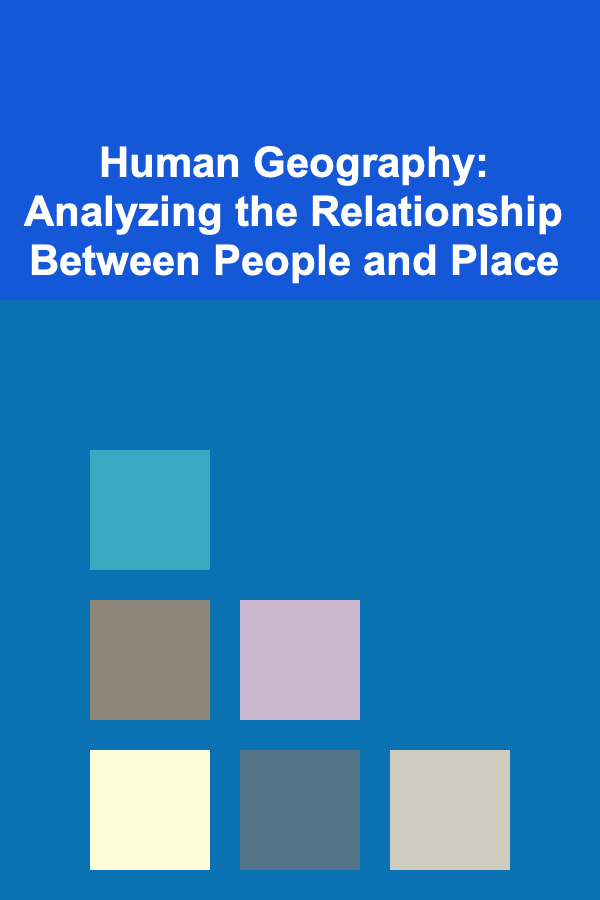
Human Geography: Analyzing the Relationship Between People and Place
ebook include PDF & Audio bundle (Micro Guide)
$12.99$5.99
Limited Time Offer! Order within the next:

Human geography is a fascinating field that explores the intricate connections between people and the environments they inhabit. It delves into how human activities and cultural practices are shaped by geographical factors, and conversely, how human beings shape the landscape. This discipline bridges social sciences and physical geography, creating a comprehensive understanding of the world we live in. The study of human geography examines numerous themes including population, migration, urbanization, culture, and the socio-economic systems that arise in different environments.
In this guide, we will explore how human geography analyzes the relationship between people and place, and why understanding this relationship is crucial for tackling global challenges.
The Essence of Human Geography
Human geography focuses on the spatial aspects of human existence. While physical geography looks at the natural environment, human geography is concerned with how individuals, groups, and societies interact with and influence the world around them.
This relationship between people and place can be viewed through the lens of space, scale, and time. Space refers to the physical location and how it impacts human activity; scale pertains to the size of the geographic area studied, ranging from local to global levels; time concerns the changes that occur over periods and how the relationship between people and place evolves.
Human geography addresses questions such as:
- How do cultural practices and beliefs shape a region?
- What impacts do human activities, like urbanization or industrialization, have on the environment?
- How does the distribution of resources affect population distribution and migration?
The Role of Place in Human Geography
The concept of "place" is central to human geography. A place is not just a physical location, but it carries meaning and significance for the people who inhabit it. It embodies history, culture, and identity. The relationship between people and place involves how the identity of individuals or communities is tied to the environment around them.
Identity and Place
Places are more than just geographical locations; they are imbued with cultural and personal significance. Human geography examines how people's identities are constructed in relation to places. For example, a community living in a coastal region might have cultural practices centered around fishing, and their sense of identity is rooted in the sea. These identities can also influence how people organize themselves socially, politically, and economically within their environments.
The significance of place also plays a role in global issues such as nationalism, conflict, and migration. Different groups often have distinct historical ties to a place, which can lead to disputes over territory or the resources that place holds.
Sense of Place and Cultural Landscapes
"Sense of place" is another important concept in human geography. It refers to the emotional and symbolic connection that people have to a particular place. This connection is shaped by personal experiences, memories, and the broader cultural context.
Cultural landscapes are visible manifestations of this relationship between people and place. A cultural landscape is the result of human activity interacting with the physical environment, creating spaces that are not only functional but also reflect cultural and social identities. Examples of cultural landscapes include religious temples, agricultural terraces, and urban architecture.
Migration and Human Geography
Migration is a fundamental aspect of human geography. It is the movement of people from one place to another, driven by a variety of factors such as economic opportunities, conflict, climate change, or personal aspirations.
Human geography analyzes migration by examining its causes, patterns, and consequences. Migration is a dynamic process that affects both the places people leave and the places they move to. For example, rural-to-urban migration can lead to the growth of cities, changing both the social fabric and the physical landscape of the area. Similarly, migration across borders can influence the demographic makeup of regions, leading to cultural exchange but also sometimes tension.
Migration plays a critical role in shaping global patterns of inequality. People in wealthier nations often migrate to developing countries in search of low-cost labor, while others leave their home countries in search of better living conditions. Refugees and asylum seekers, driven by conflict or environmental disaster, face different challenges than voluntary migrants. Understanding these movements of people is vital to addressing issues of social justice, human rights, and global sustainability.
Urbanization: The Changing Relationship Between People and Place
One of the most significant transformations in human geography over the last century has been urbanization. As more people move to cities, the relationship between people and place changes dramatically. Urbanization is not just a physical shift in where people live; it also represents a transformation in how people interact with each other and the environment.
Urban Sprawl and Development
Urban sprawl refers to the uncontrolled expansion of urban areas into surrounding rural or undeveloped lands. As cities grow, they often encroach on natural landscapes, which can lead to the loss of biodiversity and the alteration of ecosystems. Human geography investigates how urban sprawl affects the environment and how sustainable development can mitigate these negative consequences.
The development of cities also brings changes to social structures and economic systems. Cities become centers of innovation, commerce, and culture, but they also face challenges such as poverty, inequality, and environmental degradation. Urbanization can lead to the concentration of wealth and resources in certain areas while leaving others in poverty.
Gentrification and Displacement
Urban geography also explores the phenomenon of gentrification, where wealthier individuals or businesses move into low-income neighborhoods, leading to the displacement of existing residents. Gentrification often changes the character of a neighborhood and can lead to significant shifts in the social dynamics of the area. Human geography helps to understand the causes and consequences of gentrification and offers insights into how communities can manage change in ways that benefit all residents.
Environmental Impact and Sustainability
The relationship between people and place is deeply tied to environmental issues. Human geography plays a key role in analyzing how human activities, such as deforestation, pollution, and resource extraction, impact the environment. It also focuses on how people respond to environmental changes and how they can adopt more sustainable practices.
Climate Change and Human Geography
One of the most pressing environmental challenges today is climate change. The study of human geography helps to understand how climate change impacts different regions, particularly those that are vulnerable to sea level rise, drought, and extreme weather events. It also sheds light on the social and political responses to climate change, including the role of governments, businesses, and individuals in mitigating its effects.
Human geography also examines how environmental degradation and climate change drive migration patterns. For instance, communities that rely on agriculture for their livelihoods may be forced to relocate due to droughts, shifting precipitation patterns, or rising temperatures. This highlights the interconnectedness of human activities and the environment, and the need for global solutions to address these challenges.
Sustainable Development
Sustainable development is another key theme in human geography. As the global population grows, so does the demand for resources. Human geography explores how to balance economic growth with the preservation of environmental resources. It looks at the ways in which cities, nations, and international organizations can promote sustainability through urban planning, renewable energy, and conservation efforts.
The Role of Technology in Human Geography
Advancements in technology have revolutionized the study and practice of human geography. Geographic Information Systems (GIS), remote sensing, and spatial analysis tools have enabled geographers to map, analyze, and model human activities in ways that were previously impossible. These tools allow for more accurate predictions about population growth, urban development, and environmental change.
Technology also plays a central role in how people interact with places. The rise of the digital world has transformed our sense of place and community. Social media, virtual reality, and online platforms allow people to connect to places in ways that transcend geographical boundaries. These technologies influence how we understand space and place, shaping both our identities and our relationships with the environment.
Conclusion
Human geography provides a critical lens through which we can understand the relationship between people and place. It is a dynamic and interdisciplinary field that helps explain how human behavior shapes and is shaped by the world around us. From migration and urbanization to cultural identity and environmental sustainability, human geography addresses some of the most pressing challenges of our time.
By analyzing the spatial dynamics of human life, we can gain insights into how people interact with their environments and how we can create more equitable, sustainable, and livable places for future generations. The study of human geography, therefore, is not just an academic pursuit; it is a vital tool for creating solutions to the complex problems facing our global society.
Reading More From Our Other Websites
- [Home Renovating 101] How to Renovate Your Home with Eco-Friendly Materials
- [Personal Investment 101] How to Start Investing with What is a Brokerage Account When You're a Beginner
- [Personal Care Tips 101] How to Pick a Body Wash with Natural Antioxidants for Skin Protection
- [Home Budget Decorating 101] How to Follow Budget-Friendly Home Decor Trends: Stay Stylish on a Budget
- [Home Soundproofing 101] How to Soundproof a Cabinet for a Quieter Kitchen or Bathroom
- [Sewing Tip 101] How to Choose the Perfect Sewing Machine for Your Crafting Style
- [Home Cleaning 101] How to Remove Tough Stains: A Comprehensive Stain Removal Guide for Every Surface
- [Organization Tip 101] How to Create an Outdoor Workspace That Inspires
- [Organization Tip 101] How to Choose the Right Color Palette for Your Entryway
- [Home Space Saving 101] How to Arrange Furniture to Maximize Floor Space in Small Living Rooms

How to Create a Long-Term Investment Strategy for Retirement
Read More
How to Pay Off Debt Faster Without Sacrificing Your Lifestyle
Read More
How to Save Space in Your Bedroom with Under-Bed Storage Solutions
Read More
How to Utilize ChatGPT for Environmental Issue Discussion
Read More
10 Tips for Working with Leather in Upholstery
Read More
How to Craft a Wedding Seating Chart Checklist
Read MoreOther Products

How to Create a Long-Term Investment Strategy for Retirement
Read More
How to Pay Off Debt Faster Without Sacrificing Your Lifestyle
Read More
How to Save Space in Your Bedroom with Under-Bed Storage Solutions
Read More
How to Utilize ChatGPT for Environmental Issue Discussion
Read More
10 Tips for Working with Leather in Upholstery
Read More